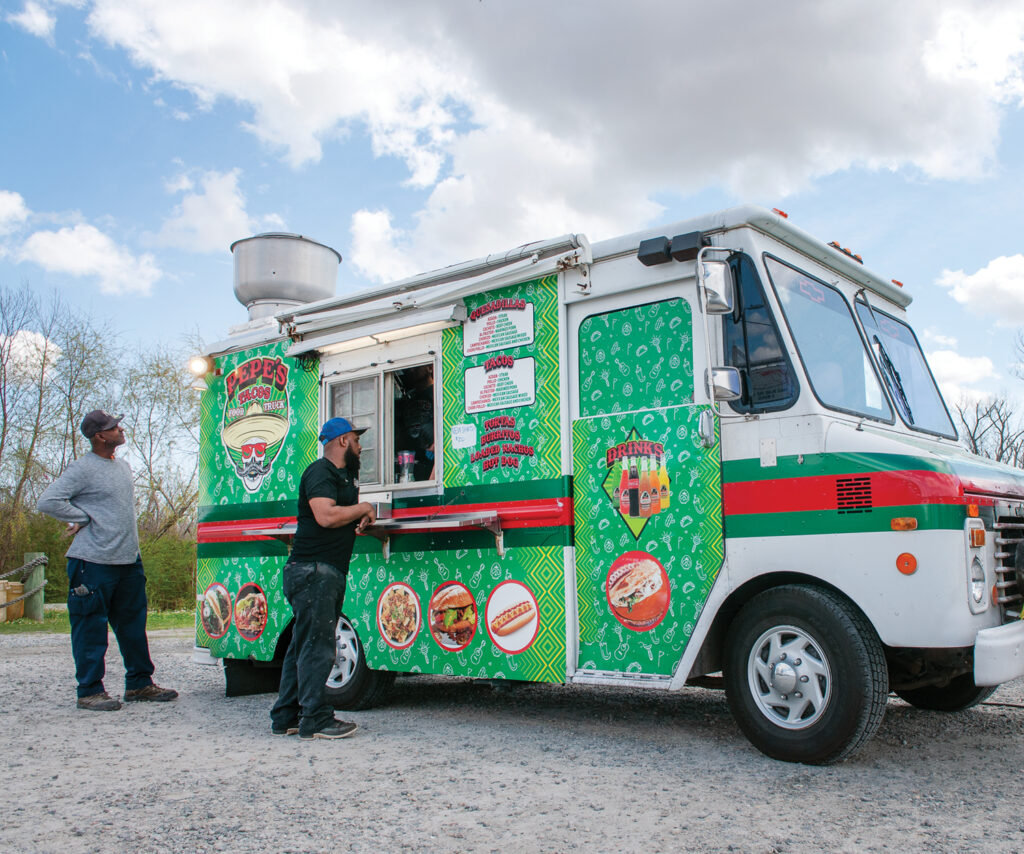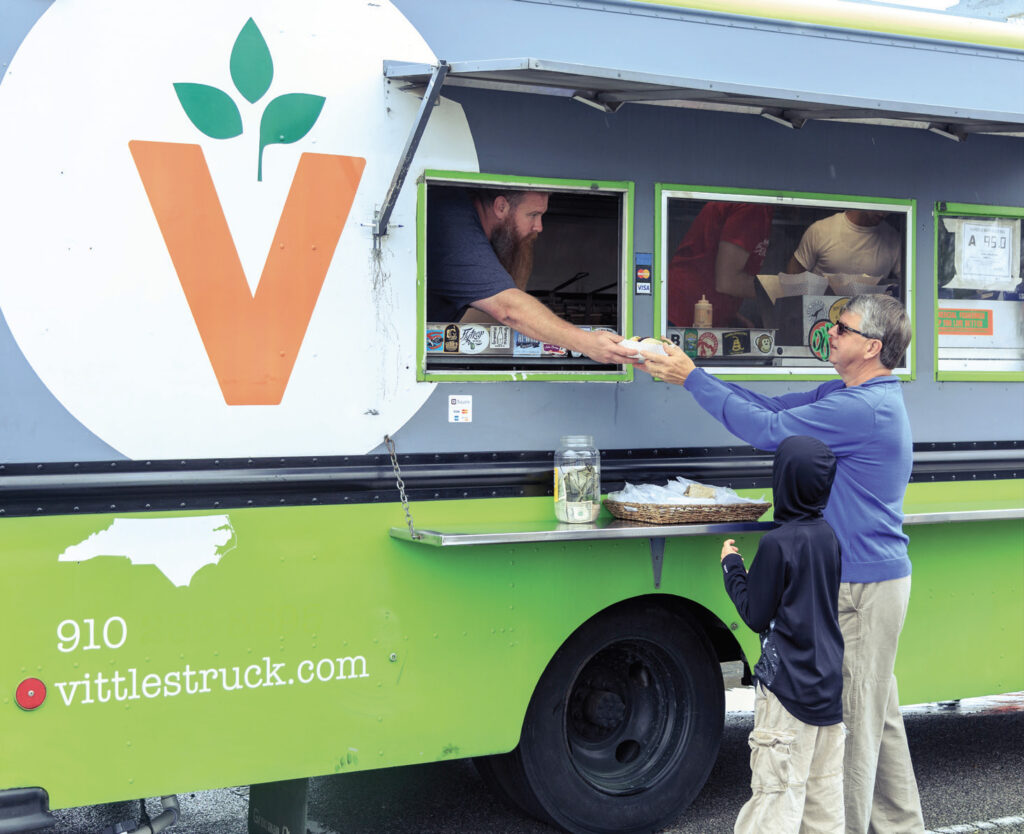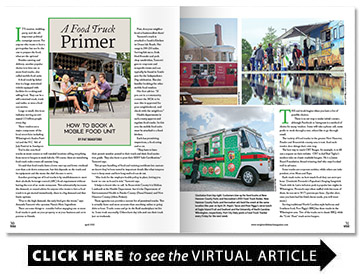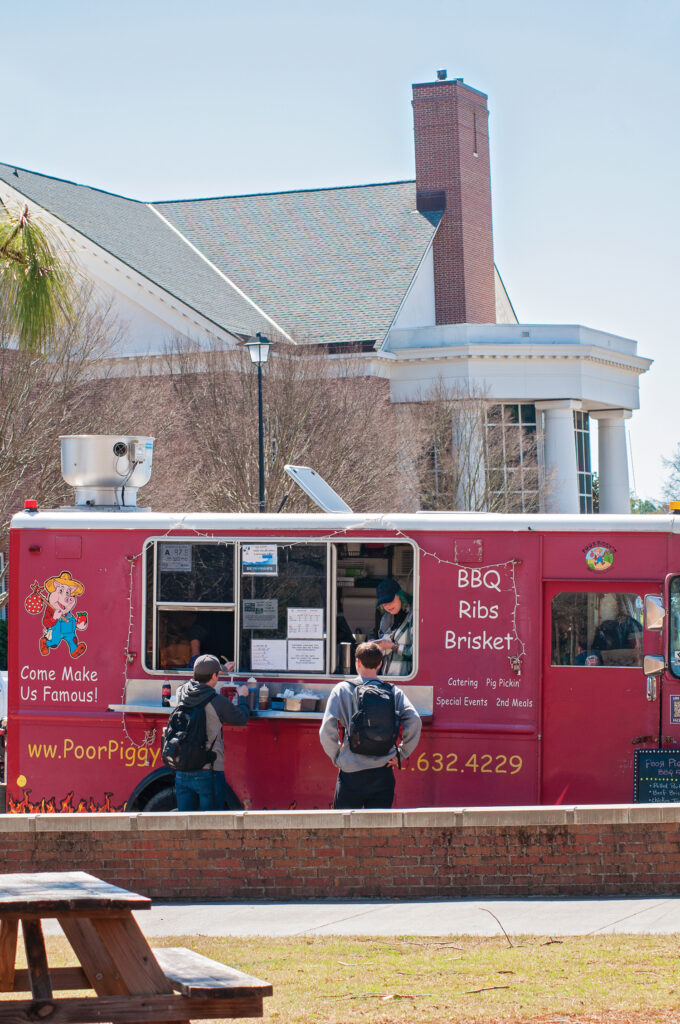A Food Truck Primer
How to book a mobile food unit
BY Pat Bradford

It’s reunion, wedding, party and the all-important political campaign season. For anyone who wants to host a get-together but not be the one to prepare the food, what are the options?
Besides catering and delivery, another popular choice is to hire one or more food trucks, also called mobile food units.
A food truck by definition is a large, motorized vehicle equipped with facilities for cooking and selling food. They can be a self-contained truck, truck and trailer, or even a food cart service.
Large or small, this is an industry serving an estimated 2.5 billion people every day.
These vendors are a major component of the local street fairs including Wilmington’s Azalea Festival and the N.C. 4th of July Festival in Southport.
You’ve also seen food trucks on street corners or well-traveled locations selling everything from tacos to burgers to steak kabobs. Of course, there are tantalizing food truck rodeo events all summer long.
It’s said that food trucks have a lower start up and lower overhead cost than a sit-down restaurant, but this depends on the truck and its equipment and the menu the chef chooses to serve.
Another growing use of food trucks is by establishments to meet their alcoholic beverage control (ABC) food requirement without having the cost of an onsite restaurant. This substantially increases the demand, so sound advice for anyone who wants to hire a food truck is to get started immediately; there is a big demand and that limits options.
“Due to the high demand, the early bird gets the worm,” says Amanda Yannotti who operates Nana’s Main Ingredient.
There are some things to consider before engaging one or more food trucks to park on your property or at your business and serve patrons or friends.
First, does your neighborhood or business allow them?
Yannotti’s truck is attached to Sarah’s Kitchen in Ocean Isle Beach. Her range is 200-250 miles. Serving fish tacos, fresh fried flounder and pork chop sandwiches, Yannotti goes to corporate and nonprofit events and can typically be found in Southport for the Independence Day celebration. She also handles bookings for other mobile food vendors.

Her first advice: “If you are in a community, contact the HOA to be sure this is approved for your neighborhood, and check with the neighbors.”
Health departments in each county approve and regulate food trucks. In this area the mobile food units must be attached to a fixed kitchen.
Each has permitting, inspections, a food rating and so on.
“They have to have their permit number posted in their truck and their food sanitation grade. They also have to post their SERV Safe Certification,” Yannotti says.
This proper handling of food and training certificate lets customers know they’ve been tested in important details like what temperature to keep meat and how long seafood can sit out.
“Also look for the employee health policy in place, letting you know no one on board is sick,” Yannotti says.
It helps to know who to call. In Brunswick County it is Melissa Lombardi at the Health Department, but it’s the Department of Environmental Health in Pender County (Dana Houser) and New Hanover County (Alicia Pickett).
These agencies can provide a current list of permitted trucks. This is actually faster and more accurate than searching online or going drive-a-bout. Trucks come and go in the fluid marketplace we live in. Some work seasonally. Others have day jobs and run their truck just on weekends.
The real work begins when you have a list of possible choices.
There is no set way to make initial contact, although Facebook or Instagram is a method of choice for many vendors. Some will take a phone call, some prefer to work through a text, others like to go through email.
The variety of food trucks in the greater New Hanover, Pender and Brunswick county area is vast. And each vendor does things their own way.
The best way to reach CBT Burger, for example, is to fill out a request on their website. CBT is chef Bud Taylor’s modern take on classic roadside burgers. He is a James Beard Foundation Award winning chef who stays booked well in advance.
Some trucks are corporate entities, while others are independent, even Mom and Pops.
Each truck varies on how much food they can serve per hour. Dominick Pirozzolo’s Papadom’s Singing Sangwich Truck with its Latin infusion pork is popular late nights in Wilmington. Pirozzolo says when staffed with his team of three, he can serve 50-75 patrons per hour. (Spoiler alert, once you have had his fried cheese curds, you will want more.)
Serving traditional North Carolina-style barbecue and Southern food, Poor Piggy’s BBQ has three trucks in the Wilmington area. Two of the trucks serve classic BBQ, while the “Goin’ Ham” truck serves burgers.
To figure out quantity, Poor Piggy’s Harley Bruce says its math by the head count. Meats by weight, sides by the quart. If each person eats a half pound, times 100 people you need 50 pounds. And a quart feeds 10 people, so for 50 people you need 5 quarts of sides, “and then I throw in a little extra.”
Wrightsville’s Trolly Stop has been serving classic hot dogs with homemade toppings since 1976. It operates three push carts.
With three trucks, Wheelz Gourmet Pizza is trying to earn “neighborhood” food truck status. The management says their 1000-degree ovens can cook a pizza in less than 2 minutes. Start to finish, made-to-order, Neapolitan Brooklyn-style wood-fired pizza is ready in 5 -10 minutes. They require a $500 minimum, which they say roughly equates to 36, 8-slice pizzas at $14 each.

Another question to ask food truck operators is how big or small a gathering will you come out for? Stephanie and Tyrone Farmer’s Dream Ice serves both smaller family gatherings and big events and festivals.
Once a vendor is chosen and the date is locked in, you can whittle down the exact menu you want. They’ll do the ordering and the prep, and they will either cook or finish cooking on site and serve out of the truck through a window.
There’s a food truck for every budget and palate. You can mix it up. Food trucks have all sorts of fare these days, from the standard barbecue, ribs and burgers to sushi and other seafood. They run the gamut from basic to high end. The ice cream and frozen ice trucks should not be overlooked either.
Sunset Slush of Wilmington operates out of a pushcart that holds four flavors of their Italian ice. Owners Cassandra and Will Kelley say one thing to have ready when you call to book, in addition to the number of people and how long you want them there, is which of their 36 flavors you want on the cart.
You pay the truck per person, or if it’s a public event then the truck collects from customers. For others, payment can be per serving or as a package.
“I do it two ways,” Tyrone Farmer says. “If they prefer, you can let the customer come on their own and pay individually, or the host can purchase a package, say if you want 500 people and each to have two servings, we calculate that as a package and then we donate a portion back to the host.”

Farmer’s Dream Ice is a sweet and frozen dessert made by the same process as ice cream, but it’s fat-free, dairy-free and cholesterol-free and is water-based.
Some trucks will work on a prepaid minimum or a guaranteed minimum. There is a difference between guarantee versus a minimum, so ask questions.
Trucks are restricted in the number of hours they can operate per day, being permitted to only work daily five hours, plus five hours. They have to carry their own potable water and power.
Length is an additional consideration. Request this information to include the truck, or trailer, if any. Some tow a support trailer with generator and need a place for a support vehicle or cargo trailer to park. Many are self-contained.
Dom’s Singing Sangwich’s rig is 40 feet by 10 feet. The Snow Cone Bus is a single unit 20 feet by 8 feet, while the Taqueria V truck and trailer is 44 feet by 8.4 feet.
Once you have identified and secured the vendor(s) and agreed on a date, beside permit number and health score, request a copy of insurances on the vehicle(s) on the portion where cooking is done and any vehicle that tows it, truck and trailer. Also request a copy of worker’s compensation if they employ three or more employees.
Rules Of The Road
To protect yourself or business, and to ensure there are no misunderstandings have a written agreement that both parties sign stipulating at a minimum:
1. That the vendor will work from the space assigned and arrive and leave at the agreed-upon time.
2. The vendor will provide quality food products and a truck that is staffed by clean professional and courteous personnel.
3. The vendor will leave the assigned space litter free.
4. The vendor agrees to meet all city, county and state laws.
5. No security is provided for the vendor, and the vendor assumes all risk of loss or damage to merchandise or property no matter how it is caused. If property is lost, stolen, or damaged, vendors agree not to look to the organizer, employee or property owner for payment.
6. Food vendor agrees to provide proof of insurance for the vehicle and the workers.


